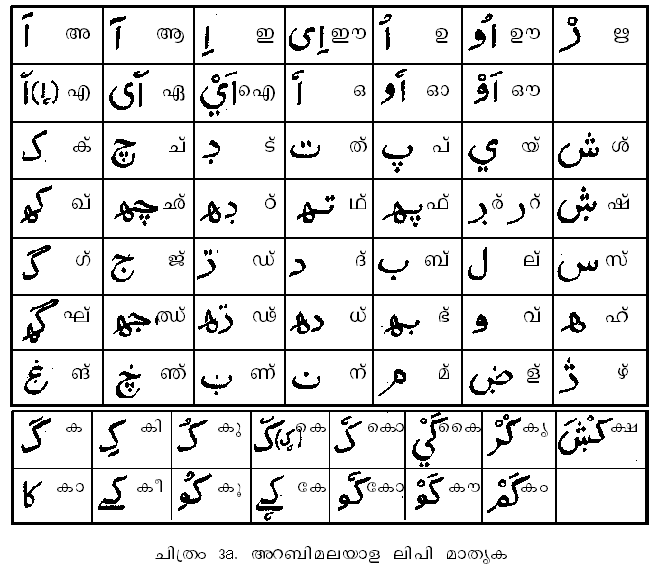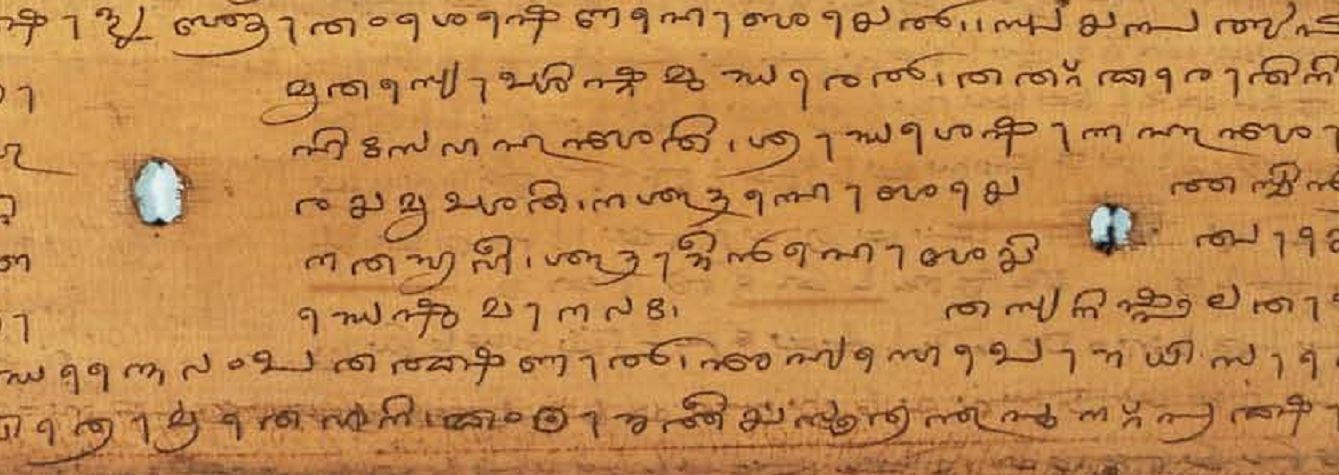|
Thirunizhalmala
Thirunizhalmala ("Garland of the Sacred Shade" or "Grace") is a c. 13th century " pattu" genre poem in Malayalam language. Along with "Ramacharitham", it is one of the earliest extant poems in Malayalam. It is generally considered as a work associated with the Vaishnavite bhakti movement in south India. It is sometimes called "the first religious work in the Malayalam". "Thirunizhalmala" was discovered by scholar M. M. Purushothaman Nair in 1980. "Thirunizhalmala" is composed, most probably by a high caste poet (from certain "Kurumur Palli"), in local meters and with Dravidian orthography. It is assumed that the work predates the famous "Ramacharitham" by around a century. The manuscript of the poem was discovered from northern Kerala. Central topic of the poem is the description of the ritual life of Aranmula Temple in Pathanamthitta. The main rites described are the ancient rituals of the Malayar/Malayarayan or Malayan community (performed to remove the various impurities of the ... [...More Info...] [...Related Items...] OR: [Wikipedia] [Google] [Baidu] |
Malayalam
Malayalam (; , ) is a Dravidian languages, Dravidian language spoken in the Indian state of Kerala and the union territories of Lakshadweep and Puducherry (union territory), Puducherry (Mahé district) by the Malayali people. It is one of 22 Languages with official status in India, scheduled languages of India. Malayalam was designated a "Classical Languages of India, Classical Language of India" in 2013. Malayalam has official language status in Kerala, Lakshadweep and Puducherry (Mahé, Puducherry, Mahé), and is also the primary spoken language of Lakshadweep. Malayalam is spoken by 35.6 million people in India. Malayalam is also spoken by linguistic minorities in the neighbouring states; with a significant number of speakers in the Kodagu and Dakshina Kannada districts of Karnataka, and Kanyakumari district, Kanyakumari, Coimbatore district, Coimbatore and Nilgiris district, Nilgiris district of Tamil Nadu. It is also spoken by the Malayali diaspora, Malayali Diaspora wo ... [...More Info...] [...Related Items...] OR: [Wikipedia] [Google] [Baidu] |
Malayalam Literature
Malayalam, the lingua franca of the Indian state of Kerala and the union territories of Lakshadweep and Puducherry (union territory), Puduchery, is one of the six classical languages of India. Malayalam literature comprises those literary texts written in Malayalam, a Dravidian languages, South-Dravidian language spoken in the Indian state of Kerala. The first travelogue in any Indian language is the Malayalam ''Varthamanappusthakam'', written by Paremmakkal Thoma Kathanar in 1785. Malayalam literature has been presented with 6 Jnanpith Award, Jnanapith awards, the second-most for any Dravidian language and the third-highest for any Indian language. The Sangam literature can be considered as the ancient predecessor of Malayalam. The origin of Malayalam calendar dates back to year 825 CE. It is generally agreed that the Quilon Syrian copper plates of 849/850 CE is the available oldest inscription written in Old Malayalam. The earliest known literary works in Malayalam are ''Rama ... [...More Info...] [...Related Items...] OR: [Wikipedia] [Google] [Baidu] |
Malayalam-language
Malayalam (; , ) is a Dravidian languages, Dravidian language spoken in the Indian state of Kerala and the union territories of Lakshadweep and Puducherry (union territory), Puducherry (Mahé district) by the Malayali people. It is one of 22 Languages with official status in India, scheduled languages of India. Malayalam was designated a "Classical Languages of India, Classical Language of India" in 2013. Malayalam has official language status in Kerala, Lakshadweep and Puducherry (Mahé, Puducherry, Mahé), and is also the primary spoken language of Lakshadweep. Malayalam is spoken by 35.6 million people in India. Malayalam is also spoken by linguistic minorities in the neighbouring states; with a significant number of speakers in the Kodagu and Dakshina Kannada districts of Karnataka, and Kanyakumari district, Kanyakumari, Coimbatore district, Coimbatore and Nilgiris district, Nilgiris district of Tamil Nadu. It is also spoken by the Malayali diaspora, Malayali Diaspora wo ... [...More Info...] [...Related Items...] OR: [Wikipedia] [Google] [Baidu] |
Malayalam-language Literature
Malayalam (; , ) is a Dravidian language spoken in the Indian state of Kerala and the union territories of Lakshadweep and Puducherry (Mahé district) by the Malayali people. It is one of 22 scheduled languages of India. Malayalam was designated a " Classical Language of India" in 2013. Malayalam has official language status in Kerala, Lakshadweep and Puducherry ( Mahé), and is also the primary spoken language of Lakshadweep. Malayalam is spoken by 35.6 million people in India. Malayalam is also spoken by linguistic minorities in the neighbouring states; with a significant number of speakers in the Kodagu and Dakshina Kannada districts of Karnataka, and Kanyakumari, Coimbatore and Nilgiris district of Tamil Nadu. It is also spoken by the Malayali Diaspora worldwide, especially in the Persian Gulf countries, due to the large populations of Malayali expatriates there. They are a significant population in each city in India including Mumbai, Bengaluru, Chennai, Delhi, Hyder ... [...More Info...] [...Related Items...] OR: [Wikipedia] [Google] [Baidu] |
Aranmula Parthasarathy Temple
The Aranmula Parthasarathy Temple is a Hindu temple located in Aranmula, a village in Pathanamthitta District, Kerala, South India, on the southern bank of Pamba river, the third longest river in Kerala. It is dedicated to the Lord Krishna, who is worshipped as Parthasarathy (Arjuna's charioteer). Constructed in the Kerala style of architecture, it is one of the "Divya Desams", the 108 temples of Vishnu revered by the Alvar saints. It is one of the most important Krishna temples in Kerala and is one of the five ancient shrines in Kerala, connected with the legend of the ''Mahabharata'', where the five Pandavas are believed to have built one temple each; Aranmula is built by the Pandava prince Arjuna. The sacred jewels, called ''Thiruvabharanam'' of Ayyappan are taken in procession to Sabarimala each year from Pandalam, and Aranmula Temple is one of the stops on the way. Also, the ''Thanka Anki'', golden attire of Ayyappan, donated by the king of Travancore, is stored here and ... [...More Info...] [...Related Items...] OR: [Wikipedia] [Google] [Baidu] |
Pathanamthitta District
Pathanamthitta District (), is one of the List of districts of Kerala, 14 districts in the States and union territories of India, Indian state of Kerala. The district headquarters is in the town of Pathanamthitta. There are four municipalities in Pathanamthitta: Adoor, Pandalam, Pathanamthitta and Thiruvalla. According to the 2011 Census of India, the population was 1,197,412, making it the third least populous district in Kerala (out of List of districts in Kerala, 14), after Wayanad district, Wayanad and Idukki district, Idukki. Pathanamthitta has been declared the first polio-free district in India. The district is 10.03% urbanised. Pathanamthitta is one of the richest districts in India with just 1.17% poverty as of 2013, which places the district among the top 5 districts in India with least poverty. Etymology The district's name is a combination of two Malayalam words, and , which together mean 'array of houses on the river side'. The district capital is located on t ... [...More Info...] [...Related Items...] OR: [Wikipedia] [Google] [Baidu] |
Vaishnavism
Vaishnavism () ), also called Vishnuism, is one of the major Hindu denominations, Hindu traditions, that considers Vishnu as the sole Para Brahman, supreme being leading all other Hindu deities, that is, ''Mahavishnu''. It is one of the major Hindu denominations along with Shaivism, Shaktism, and Smartism. Its followers are called Vaishnavites or ''Vaishnava''s (), and it includes sub-sects like Krishnaism and Ramanandi Sampradaya, Ramaism, which consider Krishna and Rama as the supreme beings respectively. According to a 2020 estimate by The World Religion Database (WRD), hosted at Boston University’s Institute on Culture, Religion and World Affairs (CURA), Vaishnavism is the largest Hindu sect, constituting about 399 million Hindus. The ancient emergence of Vaishnavism is unclear, and broadly hypothesized as a History of Hinduism, fusion of various regional non-Vedic religions with worship of Vishnu. It is considered a merger of several popular non-Vedic theistic traditio ... [...More Info...] [...Related Items...] OR: [Wikipedia] [Google] [Baidu] |
Bhakti
''Bhakti'' (; Pali: ''bhatti'') is a term common in Indian religions which means attachment, fondness for, devotion to, trust, homage, worship, piety, faith, or love.See Monier-Williams, ''Sanskrit Dictionary'', 1899. In Indian religions, it may refer to loving devotion for a personal God (like Krishna or Devi), a formless ultimate reality (like Nirguna Brahman or the Sikh God) or an enlightened being (like a Buddha, a bodhisattva, or a guru).Bhakti ''Encyclopædia Britannica'' (2009)Karen Pechelis (2011), "Bhakti Traditions", in ''The Continuum Companion to Hindu Studies'' (Editors: Jessica Frazier, Gavin Flood), Bloomsbury, , pp. 107–121 Bhakti is often a deeply emotional devotion based on a relationship ... [...More Info...] [...Related Items...] OR: [Wikipedia] [Google] [Baidu] |
Theyyam
Theyyam is a Hindu religious ritual practised in the North Malabar Region of Kerala and some parts of Karnataka. Theyyam is a ritual performance involving extended chanting of mantras and ceremonial preparations that typically span 8 to 10 hours. The ritual culminates with the placement of the ''mudi'' (sacred headgear) on the performer, a moment believed to mark the entry of the deity into the performer’s body. As part of the process, the performer consumes ''madhyam'' (toddy), which is believed to suppress personal consciousness, allowing the divine consciousness of the devatha to manifest. This practice aligns with philosophical concepts found in Hindu texts such as the Yoga Vasistha, which describe how divine entities (devatas) can enter the human body, parakāya praveśanam at a Paramanu level. There is no concept of God in Hindusim, rather the concept of Devatha and Brahmam. Hinduism traditionally recognizes a multiplicity of devatas, often cited as 33 crore includin ... [...More Info...] [...Related Items...] OR: [Wikipedia] [Google] [Baidu] |
Parasurama
Parashurama (), also referred to as Rama Jamadagnya, Rama Bhargava and Virarama, is the sixth avatar among the Dashavatara of the preserver god Vishnu in Hinduism. Hindu tradition holds him to be the destroyer of the evil on Earth. According to legends, Shiva advised him to go and liberate the Mother Earth from felons, ill-behaved men, extremists, demons and those blind with pride. He is described as one amongst the '' Chiranjivis'' (Immortals), who will appear at the end of the ''Kali Yuga'' to be the guru of Vishnu's tenth and last incarnation, Kalki. Born to Jamadagni and Renuka, the Brahmin Parashurama was foretold to appear at a time when overwhelming evil prevailed on the earth. The Kshatriya class, with weapons and power, had begun to abuse their power, take what belonged to others by force and tyrannise people. He corrected the cosmic equilibrium by destroying these Kshatriyas twenty-one times (leaving some lineages). He is married to Dharani, an incarnation of Laks ... [...More Info...] [...Related Items...] OR: [Wikipedia] [Google] [Baidu] |
Kambar (poet)
Kambar, or Kavichakravarthy Kamban (1180 CE–1250 CE), was an Indian poet and the author of the Ramavataram, popularly known as ''Kambaramayanam'', the Tamil version of the epic Ramayana.The Cyclopaedia of India and of Eastern and Southern Asia By Edward Balfour Kambar also authored other literary works in Tamil, such as Tirukkai Valakkam, ''Erelupatu'', Silai Elupatu, ''Kangai Puranam'', ''Sadagopar Antati'' and ''Saraswati Antati''. Life Kambar was born in Therazhundur. He was supported by a close friend named Sadaiyepa Vallal. He grew up in the Chola Empire under the reign of Kulothunga III. Having heard of this talented bard, Kulothunga summoned him to his court and honoured him with the title ''Kavi Chakravarty'' (''The Emperor of Poets''). Kambar flourished in Therazhundur, a village in the culturally rich Mayiladuthurai district in the modern state of Tamil Nadu in South India. Kambar is generally dated after the Vaishnavite philosopher, Ramanuja, as the ... [...More Info...] [...Related Items...] OR: [Wikipedia] [Google] [Baidu] |







